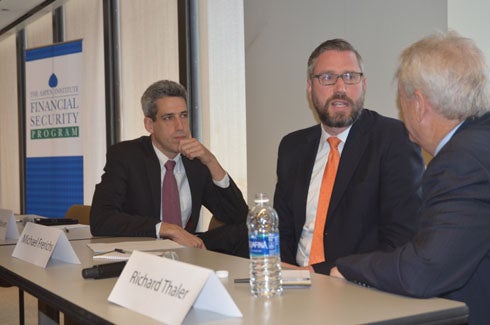Maybe you’ve heard of a “nudge” – the idea that a well-designed product or service can change behavior for the better, made famous by Richard Thaler and Cass Sunstein. But what about “sludge”?
Recently coined by Thaler, the renowned University of Chicago economist, “sludge” is the burdensome red tape or confusing fine print that undermines government programs or financial products, deterring people from accessing benefits or making the best choices. That long line at the DMV? The paperwork to buy a house? The density of the U.S. tax code? The torturous student loan process? Sludge.
Thaler explained the sludge concept, as well as other key findings from a trailblazing career in behavioral economics, during an Aspen Institute forum on the Illinois Secure Choice Program in Chicago last week.
This bold, first-in-the-nation experiment will enable automatic investment of retirement savings by private sector workers who lack employer-based retirement plans. It is projected to improve retirement security for 1.2 million Illinois workers when it goes live next year. States across the nation, and the federal government, are closely watching Illinois as a promising model to help the 68 million American workers who cannot save for retirement through the workplace.
But before it’s rolled-out, the Secure Choice Board must make key implementation decisions. According to Thaler, its biggest challenge may well be eradicating sludge.
- How will employers know if they’re required to enroll employees?
- How will firms transmit their workers’ contributions to the state investment fund?
- What happens to the account when a worker changes jobs or moves out of the state?
- Who will savers turn to when they have questions?
Thaler’s advice to the Board: “make it easy” – for employers and for workers. Remove the barriers that have historically stymied small businesses from offering retirement benefits; offer clear and simple choices, set smart defaults, and work closely with actors already in the space like asset managers and payroll service providers.
But “making it easy” to interact with the state program will require scrupulous planning before the program launches in 2017. Thankfully, the program already embraces the most important behavioral design feature: automatic enrollment through the workplace, meaning employees must opt-out if they don’t want to participate. And there are a host of other details to get right, including smoothly functioning IT systems, a user-friendly website (for employers and workers), and great customer service.
To help the Illinois Secure Choice Board think through its next steps, the Aspen Institute Financial Security Program (FSP), partnered with the Board to bring Thaler and other retirement experts to the Chase Tower in Chicago on April 25 for a discussion entitled “Averting the Retirement Reckoning in Illinois and Beyond.” (The Aspen Institute hosted a similar event for the California Secure Choice Board in September of last year.)
Watch selected clips of the event here:
Aspen FSP Executive Director Ida Rademacher kicked things off by noting how critical it is that Illinois – the first state in the nation to tackle the retirement crisis on its own – “gets the details right” and serves as a model for the rest of the country. Illinois State Senator Daniel Biss, the author of the legislation that created Secure Choice in Illinois, admitted that it’s a “terrifying honor” for Illinois to be the first state to take on this challenge but expressed confidence in the Board’s ability to effectively roll out the program. Michael Frerichs, Illinois’s Treasurer and the Chair of the Secure Choice Board, gave an update on the Board’s progress and assured attendees that the Board intends to “create a program that is well-run, transparent, and safe for participants.”

From left to right: The Honorable Daniel Biss, 9th Senate District, Illinois State Senate, The Honorable Michael W. Frerichs, Illinois State Treasurer and Dr. Richard Thaler, Professor of Behavioral Science and Economics, University of Chicago Booth School of Business.
After Thaler’s keynote address, the conversation turned to design details:
- Center for American Progress Senior Fellow David Madland stressed the importance of offering savers low-fee investment options and explained why the federal government’s Thrift Savings Plan is a model worth emulating. [slides]
- Martin Noven, Senior Director for Government Markets at TIAA, made suggestions based on TIAA’s deep experience in the market, including easing new, risk-averse savers into the world of retirement investing by enrolling them in a low-yield, guaranteed-return fund for their first 90 days in the program. [slides]
- ADP Vice President of Government Affairs Pete Isberg highlighted the importance of getting the “plumbing” right, to ensure that funds move securely and efficiently from thousands of employers to the right employee accounts. Getting this right, while not sexy, will be critical for program success. [slides]
- Lucy Mullany, who leads the Financial Empowerment Policy Project for the Heartland Alliance – one of the advocacy organizations that helped shepherd the Secure Choice bill through the legislature in 2014 – reminded the Board that many of the workers who will be eligible for Secure Choice are asset poor, unbanked, and hold volatile jobs, making it all the more important that their Secure Choice accounts be flexible, engaging, and portable. [slides]
With so much at stake for Illinois workers, and millions of others across the nation, the Aspen Institute Financial Security Program hopes to serve as a resource to the Illinois Board as it embarks on its ambitious plan. We continue to engage with other cutting edge states, such as California, that are tackling this issue in innovative ways. And we will be in Portland next month with a series of panels for the Oregon Retirement Savings Board. More details will be shared soon.
Back to the FSP homepage.

